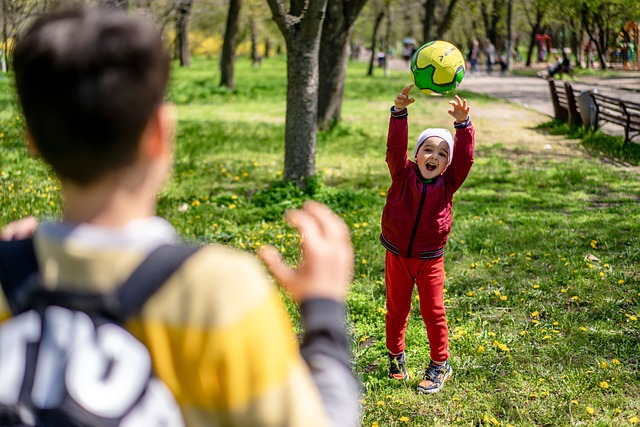Why Movement Matters More Than Ever
Let’s be real — kids are spending more time than ever staring at screens. Between online classes, gaming, and endless scrolling, movement has taken a backseat. And it’s showing. Rising screen time is tied to shorter attention spans, poor sleep, and a noticeable dip in overall mood. We’re not just talking fatigue — we’re talking fidgety, overstimulated, and burned-out kids.
But here’s the good news: physical activity doesn’t need to be intense or long-winded to make a difference. Even short bursts of movement can sharpen focus, improve sleep quality, and lift energy and mood. It’s like a system reset — one that doesn’t require high-tech anything.
Still, the key to getting kids up and moving? Make it fun. Running laps in the backyard only works for so long. But turn that into a treasure hunt or a sock-slide challenge, and suddenly it’s game on. Make movement play — the kind they look forward to — and the benefits stick.
If we’re aiming for lasting habits, then movement can’t feel like another task. It needs to feel like childhood itself: playful, unpredictable, and a little bit wild.
Tip 1: Level Up the Family Walk
Daily walks don’t have to be routine or boring — with a few creative twists, they can become the highlight of your family’s day. Here’s how to turn a simple stroll into an engaging, active experience that every age looks forward to.
Turn It Into an Adventure
Kids engage best when there’s a goal or a story. Add some imagination to your walk:
- Scavenger hunts: Make a list of things to spot — red doors, squirrels, mailboxes, flowers, or numbers on signs.
- Story walks: Let each family member take turns adding a sentence to a shared story as you walk.
- Color walks: Choose a color and see how many things you can find in that shade.
Make It a Game
Adding a challenge or playful goal can keep everyone motivated:
- Neighborhood bingo: Create bingo cards with common outdoor items or sights. First one to get five in a row wins!
- Step goals: Challenge each other to reach step milestones, tracked with apps or pedometers.
- Alphabet hunt: Find objects starting with every letter of the alphabet – in order.
Keep It Consistent but Fresh
You don’t need brand-new ideas every day, just the right mix of fun and structure:
- Rotate themes to avoid boredom – one day it’s a scavenger hunt, the next a step challenge.
- Choose a consistent time, like after dinner or before homework, so it becomes routine.
- Let kids help plan the adventure so they feel involved and excited.
With small tweaks, family walks go from “just another task” to a beloved tradition that promotes movement, creativity, and connection — all with minimal prep and zero special equipment.
Tip 2: Game-Based Movement Indoors
When the weather doesn’t cooperate or you’re short on time, indoor movement games can be a lifesaver for families. These activities need minimal space or prep—but deliver maximum energy release.
Build Your Own Obstacle Course
Transform your living room into a mini adventure park using everyday items:
- Couch cushions for hopping or crawling challenges
- Chairs and blankets to create tunnels or crawl-through areas
- Tape or string on the floor to simulate balance beams
- Secure zones for timed challenges or speed runs
Keep it timed, competitive (if your kids enjoy that), and let them help plan the setup for added engagement.
High-Energy Games That Need Zero Gear
For quick bursts of fun, these classic favorites get hearts pumping:
- Dance parties: Put on a playlist and let everyone show off their moves
- Freeze tag: Great in larger open areas, even indoors
- Sock skating: Slippery socks on hardwood or tile makes for instant sliding fun (just watch for sharp corners)
You can rotate these in five- to ten-minute rounds for variety and stamina building.
Are Fitness Video Games Worth It?
Video games don’t always mean more sitting. Select titles can actually encourage active movement in fun and intentional ways:
- Nintendo Switch Sports or Just Dance for full-body action
- Ring Fit Adventure blends exercise with an interactive story
- Beat Saber (VR) for tech-savvy families with older kids
Tip: Set time limits and treat these as supplements—not replacements—for physical play, especially for younger children.
Game-based indoor movement isn’t just about burning energy — it’s about keeping fitness playful and positive, so kids start to associate exercise with joy, not pressure.
Tip 3: Weekend Warrior Activities
Weekends are the perfect opportunity to get the whole family moving — no gym passes or packed schedules required. With the right mindset, even simple outdoor activities can feel like an adventure.
Go-To Choices for Family Fun
You don’t need a mountain or a marathon to make weekends active. Start with movement that’s accessible and naturally enjoyable for kids:
- Hiking: Stick to trails with manageable distances and bring snacks to break up the journey.
- Biking: Even younger kids can cruise on balance bikes or tow-behind trailers.
- Skating or scootering: Use paved paths in neighborhoods or parks for low-stress fun.
Find Local Hidden Gems
Too often, we overlook nearby options. Make a habit of exploring close-to-home places that offer fresh air and space to move.
- Neighborhood parks: Check for walking paths, open fields, or outdoor fitness areas.
- Nature trails: Many towns have easy trails that are stroller- and kid-friendly.
- Community centers: These sometimes offer free or low-cost weekend events that get kids moving.
Keep It Simple, Make It Exciting
You don’t need fancy equipment or a full itinerary. The key to staying active as a family is minimizing prep and maximizing engagement.
- Stick to basic gear like water bottles, helmets, and good shoes.
- Frame activities as fun adventures — not chores.
- Let each family member take turns picking the weekend outing.
The best part? These shared experiences build stronger bonds while building physical strength.
Tip 4: Chores That Work Like Workouts
Not every “workout” needs sneakers and a game plan. Sometimes, it just takes a kitchen timer and a little dust. Set the clock for 10, 20, or 30 minutes and challenge the family to clean fast and move more. Wipe windows with gusto. Race to see who can sort laundry quickest. The point isn’t perfection—it’s motion.
Chores like washing the car, pulling weeds, or raking leaves do double duty. You’re checking boxes on your to-do list while getting your steps in. Add music to boost energy or let each kid pick a playlist. Maybe it turns into a dance mop-fest. Maybe not. Either way, it’s activity that feels like play more than effort.
Want to level it up? Make it competitive. Assign zones, set goals, or give simple prizes for most cleaned, most creative, or best attitude. When fitness looks like teamwork, the pushback fades—and the laughs last longer than the mess did.
Tip 5: Try Something New Together
Introducing new activities can energize a family’s fitness routine and keep everyone engaged. Whether you’re stretching into downward dog or testing out a taekwondo kick, exploring something unfamiliar—together—can be a powerful way to bond.
Explore New Avenues
Consider trying these group-friendly options:
- Family yoga: Gentle yet effective, great for stress relief and flexibility
- Martial arts classes: Teach discipline, coordination, and confidence
- Beginner sports clubs: Soccer, tennis, swimming lessons—many programs accommodate parents and kids together
Signing Up vs. DIY Approaches
When deciding whether to join a class or go it alone, weigh these pros and cons:
Joining a Class
- Structured and consistent
- Professional instruction helps with technique and safety
- Built-in social interaction and accountability
DIY at Home
- Flexible schedule
- Cost-effective
- Allows for creativity tailored to your family’s pace
Tip: Many apps and online videos offer free or low-cost tutorials for family-friendly fitness sessions.
Kids Learn More When Parents Join In
Trying something new as a family sends a powerful message to kids:
- It’s okay to be a beginner — learning isn’t just for them
- Effort counts more than perfection
- Fitness is fun, not punishment
When kids see their parents stepping out of their comfort zone, they feel more confident doing the same. Plus, shared activities lead to shared memories—and that’s the kind of motivation that sticks.
Establishing a Routine Without It Feeling Like One
Routine doesn’t have to mean rigid. The goal here isn’t strict scheduling but finding moments that make sense — before dinner, after homework, or weekend mornings before screens take over. Pick a couple of time slots that feel natural and start there. Keep it flexible, but visible. Even a whiteboard calendar or sticky note chart can do wonders for sticking power.
Kids love seeing their efforts stack up. Use sticker charts, checklists, or simple achievement boards. Not to measure performance — just progress. Celebrate streaks, not stats. An unbroken week of movement? That’s worth a high-five. Miss a day? No shame, just keep going.
This isn’t training camp. It’s about building a rhythm the whole family can ride. When the routine becomes a habit, the benefits come easy — and so does the fun.
Staying Active Through the Seasons
Cold snaps and rainy days are no excuse to hit pause on movement. The trick is being ready before the weather turns. Have a rainy-day activity toolbox on standby—literally. Toss in jump ropes, stacking cups, resistance bands, painter’s tape (great for hopscotch or agility lines), and maybe a playlist that kicks energy into gear. Keep it all in one bin so it’s easy to grab and go.
Next, keep things fresh. Rotate indoor movement ideas like you’d rotate toys. One week it’s a living room obstacle course. Next week, a sock skating challenge on hardwood floors. Set up hallway bowling, mini yoga sessions, or family dance-offs. Kids need novelty to stay engaged, and honestly, so do adults.
When cabin fever hits, lean into short, high-energy bursts. Ten minutes of wild movement can be more effective than an hour of slow dragging. Just make it simple, fun, and consistent. Snow or no snow, your family doesn’t have to sit still.
Final Thoughts: It’s About the Bond, Not Just the Burn
It’s easy to get caught up in steps, reps, and screen-free targets. But at the end of the day, what matters most isn’t the perfect workout — it’s the time spent together. A ten-minute dance break or a backyard clean-up with music blasting can do just as much for your family’s connection as it can for your heart rate.
You don’t need to train like athletes, and there’s no gold medal for getting it right every day. What counts is the habit of showing up — being present and making movement part of the rhythm of home.
And when you’re out of ideas, or need a little boost, there’s no shame in getting help. Find fresh sparks over at MomSmartHub, where simplicity and family-first always come standard.


